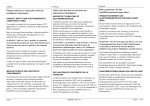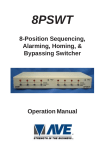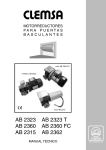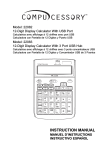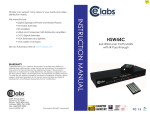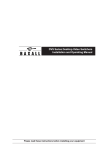Download Pyramid Ac receiver Operating instructions
Transcript
TM Installation Instructions Manual 3 - AC Receiver PY-ACW Use this manual in conjunction with : • Manual 1 : Operating Instructions • Manual 2 : Network Wiring The manuals supplied with the separate items in your system Please read this manual completely before installing your AC receiver Product Safety Please follow these instructions as you install your pyramid module and keep them for future use. If you have any problems contact your Baxall agent. WARNING: Installation is only to be carried out by competent, qualified and experienced personnel WARNING: Wire in accordance with your national wiring regulations. Failure to do so can result in injury or death by electric shock WARNING: Use a class 2 isolated power supply for the 12V DC Definitions Mains - this refers to the mains supply voltage labelled on your AC receiver power supply P/T head - Pan and Tilt Head LIVE and NEUTRAL refer to mains SUPPLY and RETURN are used to refer to 24V AC Product Reliability CAUTION: Your module is susceptible to damage from Electrostatic Discharge (ESD)). Take normal ESD precautions when handling your network card. ESD prevention kits are available from most electronics distributors. CAUTION: Do not exceed the voltage and temperature limits given in the specification. CAUTION : Switch off the power before fitting a network card. Page 2 Electromagnetic Compatibility (EMC) CAUTION : This is a Class A product. In a domestic environment this product may cause radio interference in which case the user may be required to take adequate measures. CAUTION : If you are using the PCB version of this product in any way other than correctly installed in our Pyramid System weatherproof boxes, then it is your responsibility to meet EMC requirements. This product is intended for use in general purpose CCTV applications in a residential, commercial or light industrial EMC environment, refer to Baxall Security before using the product in an industrial EMC environment. The product must be installed in accordance with good installation practice for EMC to enable the product to function as intended and to prevent EMC problems. Contact Baxall Security Technical Support Department to obtain a specification defining the acceptable levels of product degradation with regard to EMC immunity. MANUFACTURER’S DECLARATION OF CONFORMANCE CAUTION : The declaration of conformance applies only to the boxed version and PCBs which are correctly installed in our Pyramid System weatherproof box. Baxall Security Ltd declare the Pyramid module supplied with this manual is compliant with the essential protection requirements of the EMC directive 89/336 and is tested to the requirements of standards EN 55022 for emissions and IEC801 parts 2, 3 and 4 for immunity. The product has been approved in accordance with TCF95/11/01. Page 3 Unpacking Keep your packaging for use if your AC receiver is stored for a time or needs to be returned for whatever reason. The packaging should contain:• Your PY-ACW, AC receiver with PS1 or PS5 (24V AC) • An A4 Module Description sheet (for installation details) • These Instructions • Two identical bar-codes Check the product code on the serial number label. If you have an incorrect item or it is damaged then inform the suppliers and carriers immediately. If this is the case then do not attempt to use your AC receiver. These Instructions These instructions allow you to install your Pyramid AC receiver, they do not contain any application information. As the installer you are assumed to have a sound knowledge of how AC receivers operate, if you have not then contact a CCTV installation company for advice. If you are replacing a receiver on a network which is already operational then see Manual 1 - Operating Instructions for instructions on connecting a new receiver using the keyboard. The connection diagram is shown on the next page. Using this follow the instructions. The instructions are listed by connector and describe wiring your AC receiver to the P/T head, the lens, the network and the power supply. At the end of the connections section is a description of the on-board test routine, once the tests are complete and all the connections are correct your AC receiver needs no maintenance. Bar Coding All the pyramid modules are supplied with two identical bar-codes, remove one and affix it to the module description sheet, remove the other and affix it to the module. The bar code gives the unique 48-bit module address. Make a careful note on your module description sheet of all your installation details and the location of the module. Then during subsequent installation using the Windows™ installation tool the module address can be entered (using a bar code reader) with the description. Page 4 We recommend that during a system installation you store the module description sheets in a ring-bound file, and keep them for reference after the installation is complete. Figure 1. AC Receiver PCB connections Page 5 Connections Below is a description of each of the connectors. The connections are described in numeric order, followed by video, network and power connections. CON1 CON1 is for the PCB power connection. This power controls the switching of the relays, the video gain and lift and the lens functions. AC power for the P/T head and auxiliaries is connected separately to CON5. The PCB requires a +12V DC ± 10%, 1A class 2 power supply, this is already connected. Referring to figure 1 connect the +12V DC and 0V (return) to CON1. If the polarity is correct when the power is switched on then LED1 (see figure 1) is green. It appears red for an incorrect polarity. CON2 If you are using a preset P/T head and lens then CON2 provides the supplies and feedback (FB) connections for the pot-wiper circuits. The direction of the feedback is automatically calculated when the test routine is invoked (see Testing on page 9), this means it is not necessary to wire the pots in a specific direction. Referring to figure 1, connect CON2 to the preset pots on the P/T head and the lens. Connect any unused feedback inputs to ground. Make a note on your module description sheet of the preset connections and the type of lens. CON3 CON3 contains the lens drive outputs for focus, iris and zoom. The drive voltage is +10V DC at up to 100 mA. Refer to your lens instructions and connect up your lens according to figure 1. CON4 CON4 contains the power output connections for your P/T head and auxiliaries (AUX A, AUX B, AUX C and AUX D). Page 6 CAUTION : Your application must not draw more than 1A per relay or it will damage your AC receiver CAUTION : Connect lamps using a separate relay because they draw an initial surge current which may damage your AC receiver Referring to CON4 on figure 1 connect LEFT, RIGHT, UP and DOWN to your P/T head and AUX A to wash, AUX B to wipe, AUX C to lamps and AUX D to camera power. Do not connect any unused auxiliaries. Connect all the return (neutral) wires to the spare terminals on the external terminal block. Make a note on your module description sheet of your auxiliary connections. CON5 CON5 accepts the AC power input which is switched to CON4 (pan, tilt and auxiliaries). It powers the P/T head and auxiliaries. WARNING : Never use both 24V AC and Mains on the same receiver PCB. For mains . . . Referring to figure 1 connect CON5 to the LIVE and NEUTRAL connections on the external terminal block. For 24V AC . . . Referring to figure 1 connect CON5 to the SUPPLY and RETURN connections on the 24V AC power supply. The middle connection on CON5 is Not Connected (NC). CON6 CON6 is for an anti-tamper switch input. It is connected in parallel with the anti-tamper switch shown on figure 1. The anti-tamper switch has a spring fitted and so you cannot use CON6 (unless you first remove the spring). If you are not using the built in anti-tamper switch then connect CON6 on figure 1 to your anti-tamper switch in a N/C configuration. VIDEO All video must be via 75 ohm BNC connectors and video coaxial cable. Your AC receiver has an on-board video amplifier with gain and lift. Adjustment of gain and lift is done remotely, using a Pyramid keyboard. Page 7 Referring to figure 1, connect the video from your camera to VIDEO IN, through your AC receiver, then from VIDEO OUT to the matrix. NETWORK CAUTION : To avoid damaging your module switch off the power before fitting the network card Switch off the power, fit a network card in the position indicated on figure 1. Connect the cable provided from the network card to the filter board mounted on the metal base plate. Connect the network to the filter card. The wiring diagram is included on the sheet provided with the network cards. POWER WARNING : Ensure that the power is switched off before connecting the mains wires WARNING : Your PY-ACW module must be earthed Connect the Live, Earth and Neutral wires from the mains supply to Live, Earth and Neutral on the external terminal block. Check that all the wiring is correct and switch on the power. WARNING : Your AC receiver PCB now contains live voltages LED Power Indicator LED1 (see figure 1) indicates the polarity of the 12V DC. For correct polarity it is green, incorrect it is red. Page 8 Testing Your AC receiver has an on board test procedure which steps through outputs in the sequence shown in Table 1. The test push button is shown in figure 1. The test takes 55 seconds. Running the test procedure also allows your receiver to detect the feedback polarities for your P/T head and lens. WARNING : Your AC receiver PCB now contains live voltages Using an appropriate tool, press the test push button. Table 1. The Automatic Test Sequence Step Action Time Step Action Time 1 Right & Down 5s 12 Zoom Out 3s 2 Pause 2s 13 Zoom In 3s 3 Pan Left 3s 14 Pause 2s 4 Pan Right 3s 15 Iris Close 3s 5 Pause 2s 16 Iris Open 3s 6 Tilt Up 3s 17 Pause 2s 7 Tilt Down 3s 18 AUX A 2s 8 Pause 2s 19 AUX B 2s 9 Focus Near 3s 20 AUX C 2s 10 Focus Far 3s 21 AUX D 2s 11 Pause 2s 22 Exit Replacing the Lid WARNING : Refit the lid securely to prevent unauthorised access Tighten the four securing screws with an appropriate tool until they cannot be undone by hand. Do not exceed a torque of 4 Nm. Maintenance Once your AC receiver is correctly installed and commissioned it requires no routine maintenance. Changing the Fuse The fuse holder (see figure 1) contains a 10A A/S fuse for protecting the relay outputs. To replace the fuse, switch off all power to the module, turn the top anticlockwise using an appropriate tool, change the fuse and replace the top. Page 9 Specifications Features Bar coding for ease of installation Automatic configure and remote setup Anti-tamper switch detects opening of lid, also external connection provided. All connections removable (except CON5, LIVE and NEUTRAL) screw terminal blocks 128 Presets, all functions. Preset resolution, 10-bit Random Pan / Patrol / Electronic end stops Test button Lens Drives Zoom, focus and iris, 10V DC (max 100mA) Network Plug in network PCB, PY-FTT, PY-485, PY-422, PY-F17, PY-F19 Relays P/T head relays 4 auxiliary relays for wash, wipe, lamps and camera power Relay outputs Max 240 V at 1A Fuse 10 Amp Anti-Surge Video: Via BNC connectors Video 1V pk-pk PAL/NTSC Max Gain >5dB Max Lift >4dB at 4MHz Power Board Power 12V DC ± 10%, 1A class 2 Relay Power max 240V AC, 10A Nominal Consumption 8.5 Watts (12V DC) Physical Weight 5 kg PCB Weight 0.5kg Page 10 IP65 case Board size 130 x 160 x 40mm (excluding mounting pillars) Box Size 280 x280 x130mm Temperature Specification Operational temperature limits:-10ºC to +50ºC at 10% to 80% relative humidity (non-condensing) Storage temperature limits:-20ºC to +60ºCat 10% to 95% relative humidity (non-condensing) Page 11 %D[DOO6HFXULW\/LPLWHG Stockport, England Baxall Security Ltd. Reserve the right to make changes to the product and specification of the product without prior notice to the customer. HBPYAC Issue 1 : 12/95












